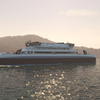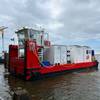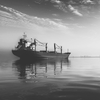UK Shipyard Orders Second Tube Bender
A second state-of-the-art tube bending machine has been ordered by BAE Systems Submarine Solutions to support the construction of the UK's Astute class nuclear-powered submarines. The new tube bending machine is an all-electric model with precision software-controlled servomotor movement, for bending tube diameters up to 76 mm. It also features an advanced laser measurement system that monitors any deviations to the programmed bend caused by the tubing material's 'springback' characteristics, and then automatically adjusts the bend to produce the correct shape. These features equip BAE Systems to handle the very demanding workload of the Astute submarine program. This involves producing a large number of complex tubular parts, often in small quantities and from expensive alloys such as corrosion-resistant cupronickel, just-in-time to meet the demanding production requirements as work progresses along the vessel.
The need for the new machine arose as a result of a decision to replace an ageing hydraulically-powered tube bender. Unison won the tender in competition against two other major machine suppliers. BAE Systems' experience with all-electric tube bending - which started with the installation of a 20mm Unison machine in 2008 - was an important factor in the decision.
The elimination of scrap provided by Unison's springback correction system, which is believed to be unique on the tube bending market, was another important criteria. This new technology is already in use at the company's sister site in Scotstoun, UK where BAE Systems Surface Ships is employing a laser-measurement-equipped Unison bender on the construction of the Royal Navy's Queen Elizabeth class aircraft carriers.
A reduction in power consumption provided a further important advantage. As the all-electric Unison machine has no need to run a hydraulic pump continuously, a significant level of electricity is only required when the machine is actually forming a bend, so energy consumption is reduced substantially, typically by around 90%.
Additionally, Unison had to design the machine so that it would accept all of the existing tooling for the old 60 mm hydraulic machine, and develop a software link to BAE Systems' central database, where the construction information is stored. This utility automatically creates a bending program from the part specification, allowing the business to set up the bender for a new part in seconds, if the tooling is already on the machine.
The seven-boat Astute program is one of the largest and most complex engineering projects under way in the UK today. An Astute class submarine has a million individual components and 10,000 separate design and engineering requirements. The first-of-class HMS Astute has been handed over to the Royal Navy and is completing sea trials before going into operational service. Second-of-class Ambush is undergoing final commissioning and testing at Barrow before leaving for sea trials. Boats 3, 4 and 5 are in various stages of build and steel is due to be cut on the sixth submarine next year.
"All-electric benders are ideally suited to the naval boat building environment, as their software-controlled set up provides versatile support for the constantly changing workload," says Jim Saynor of Unison. "With material costs spiraling we have seen an upsurge in demand for our springback correction system as well, and this feature should eliminate virtually all of the scrap wastage that can be commonly generated when manually setting up a hydraulic machine for a precision bend."
The machine will be delivered at the end of Q1, 2012.










